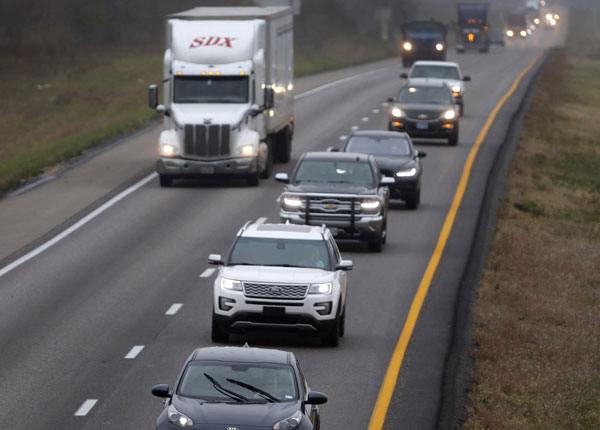
Passing Other Vehicles: Safe Passing Rules & When Passing is Illegal
Updated Oct. 20, 2020Passing another vehicle will always temporarily increase the risk you are exposed to at any given time on a stretch of roadway. However, passing will sometimes be necessary to mitigate other dangers, for instance, when a vehicle in front of you is traveling too slowly. We will discuss when you should pass another vehicle, how you should execute that pass and what you must do when another driver seeks to pass you.
Passing for safety
In optimal conditions, it is always wise to drive as close to the posted speed limit as possible. When all vehicles on the roadway are traveling at the same speed, there is less opportunity for conflict or congestion to occur.
Sometimes, you may encounter a driver on the roadway ahead of you who is traveling too slowly for you to obey the posted speed limit and maintain a safe following distance. This could be because they are experiencing a mechanical problem with their vehicle, or simply because they are being overly cautious. In such situations, you should seek to pass the slower vehicle if it is safely possible. When you cannot safely pass, reduce your speed instead. Do not tailgate under any circumstances!
As passing is always risky, you must fully evaluate the situation before attempting the maneuver. On a two-lane road with one lane for traffic moving in each direction, passing will involve merging into a lane occupied by oncoming traffic. You should only pass by merging into an opposing lane of traffic if you are certain there is a large enough gap between vehicles for you to pass and merge back into the right-hand lane safely.
When is it safe to pass?
In deciding if it is safe to pass, drivers must consider whether traffic, road and weather conditions afford them enough time to complete the maneuver. Never attempt to pass another vehicle if doing so would put you in greater danger than continuing to follow it. In general, motorists should only entertain passing if they are traveling at least 10 mph faster than the car they wish to pass. Even then, waiting for a safe opportunity is essential.
Remember that most situations require passing on the left-hand side of the vehicle in front. Passing on the right – an issue discussed in our next article - is permitted only in certain rare circumstances.
Before signaling your intention to pass the vehicle in front of you, ask yourself the following questions:
- 1

Is passing legally permitted on this stretch of the roadway?
Look out for pavement markings or road signs which indicate that passing is not allowed. - 2

Can you see far enough ahead?
Your view of the roadway must be unobstructed by trees, buildings, curves and other obstacles. - 3

Is any other vehicle attempting to pass you?
Do not proceed if any vehicle on the roadway around you could interfere with your maneuver. - 4

Do you have enough space to complete the pass safely?
Ideally, you should wait until there is a gap between your car and any oncoming vehicle that is at least twice the size of the space you need to pass. You should be able to reenter the right-hand lane before any oncoming traffic comes within 200 feet of your vehicle.
Signal your intention to pass
Communicating your intention to pass before beginning the maneuver is essential. You must make sure that all other vehicles in your vicinity recognize your intentions. In most cases, activating your left-turn indicator and moving toward the left side of your lane should make your intentions clear. Though, it may sometimes be necessary to flash your headlights or tap your horn to warn the driver in front, if you believe they are not prepared for you to pass.
When passing is permitted
Obviously, there is a great deal to consider when deciding if passing is both legal and safe in any situation. Often, traffic control devices such as pavement markings and road signs will make it abundantly clear when passing is prohibited. In other situations, you must rely solely on your judgment and knowledge of road rules. For example, did you know passing is illegal at railroad crossings and intersections? Following this introduction, “When Passing is Permitted” explores general passing rules, laws and other essential information.
Passing hazards
If passing the vehicle ahead of you creates a dangerous situation, you could be cited for dangerous driving even if passing is generally permitted on the roadway. Always check for hazards before you pass and continue to monitor the situation as you complete the maneuver. In an ideal world, the driver you are passing will do their best to allow you to pass, though you must be prepared for unexpected complications. For instance:
- An oncoming car in the left-hand lane may speed up or be traveling faster than expected.
- The car you are passing may speed up.
- Unexpected road conditions impede your ability to pass.
If any of the above situations occur before you have passed, reduce your speed and signal your intention to merge back into the right-hand lane behind the vehicle.
Blind spots when passing
In addition to checking your mirrors, always look over your shoulder to check your vehicle’s blind spots before signaling your intention to pass. You may otherwise miss another driver who is in the process of passing you. Do your best to avoid driving in the blind spots of the vehicle you are passing, or they may fail to see you and accelerate or attempt to change lanes. Never linger in another vehicle’s blind spots while passing them or for any other reason.
Steps to passing safely
Passing hesitantly can be just as dangerous as passing without due consideration. Your aim should always be to complete the pass in a controlled manner, yet in the shortest possible time. Follow these steps when passing, to complete the maneuver confidently and safely:
- 1

Signal your intention to merge into the left-hand lane.
- 2

Increase your speed as you prepare to merge left, so that you may pass as quickly as possible.
- 3

Merge into the left-hand lane and maintain a safe passing speed until you can see the front tires of the car you have passed in your rearview mirror.
- 4

Signal your intention to merge back into the right-hand lane.
- 5

Merge right and deactivate your turn signal.
- 6

Maintain your speed until there is a safe distance between your vehicle and the car you have passed.
- 7

Return to safe cruising speed.
Allow others to pass you
The final article of this section deals with an essential but often overlooked safety topic: allowing other drivers to pass you. Whenever another driver is passing you or indicates their intention to pass, you must maintain or reduce your speed and move over to give them space. Never speed up when another vehicle is passing you, even if you believe they should not be attempting the maneuver in the first place. Accelerating will only make the situation more dangerous!




